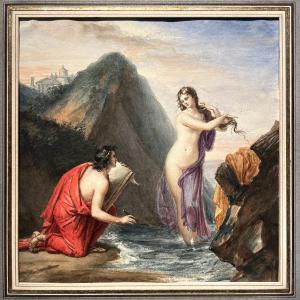(London, 1789 – Paris, 1873)
Apelles and Phryne
Gouache
H. 19.3 cm; W. 18.3 cm
Signed lower left
1826-1827
Related work: painting exhibited at the Paris Salon of 1827, under number 230, for which our drawing is preparatory.
Provenance:
- Collection Marie-Madeleine Aubrun (1924-1998)
- Collection Hans A. Lüthy (1932 - 2009), former director of the Swiss Institute for the Study of Art
Like his colleague Grenier de Saint-Martin, Louis-Charles-Auguste Couder was the son of a former colonist from Saint-Domingue. After a short stint in the studio of François-André Vincent, he was trained by Regnault, then by David; He was a painter of history, biblical and mythological subjects, although he produced a few portraits. Although he made his debut at the Salon in 1814, it was with Le Levite d'Ephraïm, at the Salon of 1817, that he achieved fame and recognition from the State. From then on, he produced decorative paintings for the Louvre, paintings for the Versailles Museum under Louis-Philippe, was a member of the Académie des Beaux-Arts in 1839, and was made an officer of the Legion of Honor in 1841. He also painted churches, for example for the Madeleine, Saint-Germain l'Auxerrois, or Notre-Dame de Lorette. At the Salon of 1827, Couder exhibited six paintings, including Apelles et Phryné (which would also be presented at the Exhibition of the Société des Amis des Arts de Lyon in 1836, under the number 56, described as belonging to Monsieur Monneret). The painting (75x65 cm), bearing an apocryphal signature, recently went on sale with an erroneous attribution to Jacques-Antoine Vallin, under the title Apelles peignant Phryné comme Vénus. This is a rather rare subject: the famous Greek painter Apelles (who was notably in the service of Philip of Macedon and then of Alexander), working on his painting Venus rising from the waters, took the superb courtesan Phryné as a model. Phryné had also posed for the sculptor Praxiteles, the latter, like Apelles, having also been her lover. The main difference between our gouache and the final painting lies in the presence of a servant on the right, who "replaces" the rock.




































 Le Magazine de PROANTIC
Le Magazine de PROANTIC TRÉSORS Magazine
TRÉSORS Magazine Rivista Artiquariato
Rivista Artiquariato